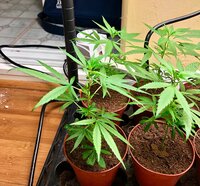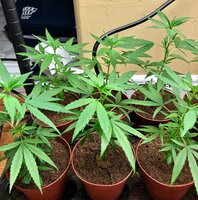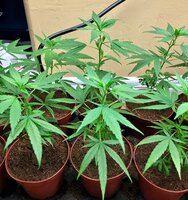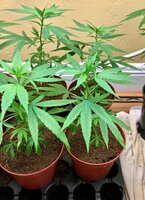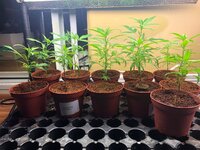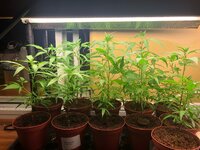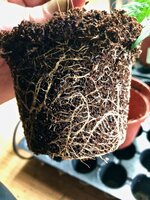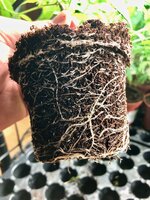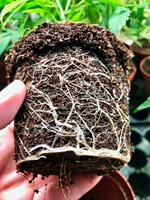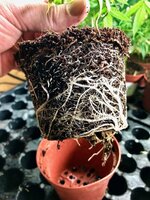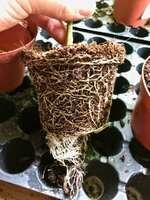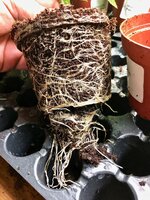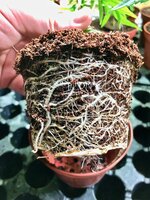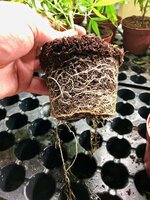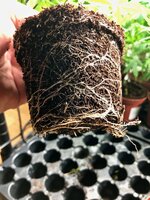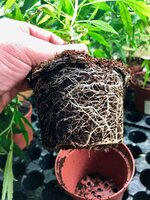Hello Fellow Growers! I have finished the first test of the many experiments I want to perform on Kelp. The first test dealt with two species of kelp. One called Ascophyllum Nodosum which is the most well-known and used kelp on the market. The other species is called Ecklonia Maxima and is being used to make a couple of different products out in the market today. Each species tends to grow in different parts of the world and seem to have their own specific benefits. Through lab testing, people have found a way to use technology to be able to determine or count the amount of phytohormones, vitamins or secondary metabolites contained within the cells of the kelp. Through this testing, some groups have found that the species Ascophyllum Nodosum has higher cytokinin counts while the Ecklonia Maxima species tested with higher auxin counts.
My Hypothesis:
To see if we can truly control the cannabis plants physiological growth by feeding it specific kelp varieties. If we feed the Ascophyllum Nodosum kelp to the plant, then we should see more of a cytokinin response which deals with a little bit of root growth but generally more shoot initiation, growth of lateral buds and bud formation. If we feed the plant the Ecklonia Maxima kelp then we should see more of an auxin response such as leaf expansion/enlargement, increase cell walls as well as strong root growth.
Experiment Info:
In this test, I used one of my rooms in my house to grow. I kept the temperature and relative humidity in the right levels for this stage of growth at 76 Fahrenheit and RH of 65 on average. The light used in this process was a T5 fluorescent 5 bulb reflector set evenly placed over all the clones. The media used was some recycled coco of mine so that I could have a small amount of food within the media for the plants start. I used genetics that are stable from the Sour D X TrainWreck mother I have. I cut a total of 10 clones all the same height and stem diameter so that they can be starting at the same levels. Some were fed Ascophyllum species while the others were fed the Ecklonia Maxima. There were no other added nutrients used to ensure that we can truly see what the kelp does to the plant. Also, each plant was fed the exact same amount of water as I made their food in water bottles for each rate of product. Each rate of kelp I used was based off the application rates recommended by the manufacturer. Each rate was tested on 2 clones meaning that clones 1 and 2 were fed Ascophyllum with a rate of 2ml/Gal, clones 3 and 4 were fed Ecklonia with a rate of 5ml/Gal , clones 5 and 6 were fed Ecklonia with a rate of 10ml/Gal , clones 7 and 8 were fed Ecklonia with a rate of 15ml/Gal , and clones 9 and 10 were fed Ascophyllum with a rate of 5ml/Gal.
Kelp Products Used:
The two kelp products used in this study both used similar extraction techniques in order to develop their products. The Ascophyllum kelp source used was from a company called 3Gem nutrition with their product called Jewel I got from their website. The Ecklonia Maxima kelp source I used was from a company called Tag Solutions called Herb N’ Grow on amazon. They both extracted and made their kelp products through enzymatic extraction which seems to be the best process to make a kelp product as it helps contain all the beneficial phytohormones and secondary metabolites. The Jewel product claims it is super concentrated thus the small rates of 2-5ml/Gal. But the issue with this product is that they added potassium hydroxide in their which tends to be harsh on the kelp and destroy the beneficial items kelp has such as alginic acid and mannitol. Lastly, I have used many kelp products before and they all tend to have a similar smell, look and consistency. This product seemed to fizz a little after mixing with my water but had the usual brown color. The Herb N’ Grow product harvests their kelp, then will hydrolyze and use enzymatic digestion to try and obtain the highest amounts of beneficial material that the kelp contains. They also don’t seem to use any harsh methods or items such as potassium hydroxide which is promising. They give rates 5-15ml/Gal depending on the stage of growth. The smell was decent and had a normal color but slight thicker consistency then others.
What I am thinking will happen:
At the end of the test, the plants fed with Ecklonia Maxima should have better root structure since it contains higher auxins than the other species. The Ascophyllum species should also help with root growth but not as well as the other species because of the difference in auxin counts. The Ascophyllum species would be more beneficial during flowering to help with shoot growth as well as bud formation/growth.
Results:
I judged based off which clones have the best rooting response and was curious to examine what happens with top growth and leaf formation as well. Next I will post some pictures taken each week after the clones were transplanted into small pots. I wanted to make sure to let the roots grow out after the clones got transplanted so I let them grow for a total of 3 weeks. In the pictures you will see the top growth vary each week depending by each rate used. The plants fed with the Ecklonia Maxima kelp did end up having better root structures then the other species. They also seemed to have slightly bigger leaf structure and faster growth which makes sense as an auxin response. The Ascophyllum Nodosum species had decent root growth but not as developed and as strong as the Ecklonia fed plants. The Ascophyllum species did seem to be a little bushier and must have focused its plants energy towards shoot growth more than root growth.
Conclusion:
With these different species of kelp, we could possibly have more control over our plants physiological response to help us ensure a healthy and strong crop. The thing that bothered me with this test, is that all kelp products have different extraction methods. I tried to use two kelp products with similar extraction methods to get a full look on what the difference in kelp species can do for the plant but I am worried that by one company using potassium hydroxide in their process, it could have messed up my results because one product would be stronger or contain more beneficial secondary metabolites. But what is promising is that the results I came up with seemed to be more phytohormone related because of the physiological growth that occurred with each plant. I definitely want to test this again to ensure that what I found is correct as far as kelp species being the reason for these results instead of it being based off which product was extracted better. Next I want to compare the same species of kelp but test out which product works best based off which extraction method was used to make the product. I also am planning to test kelp with all the different medias and see how the results change from using coco and living soil. Please be open to your own testing and see what you find or sit back and see what I come up with. Please give feedback if there is anything I can do to better this process as I am no scientist but looking to help us all as growers. My next post will be of the pictures!! Happy Growing To All!!!!




